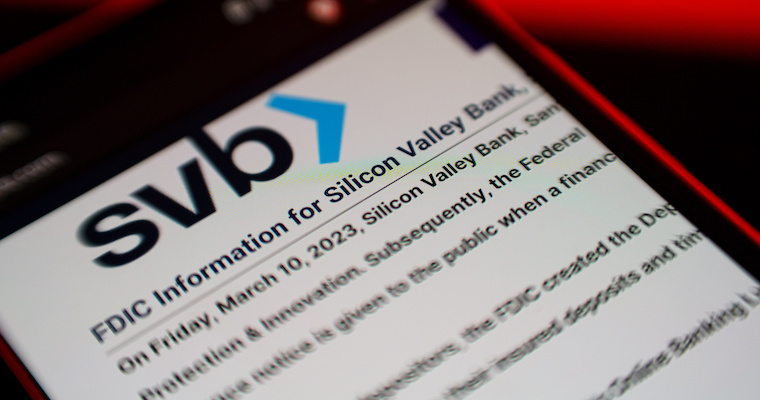The Silicon Valley Bank Bust: What Entrepreneurs Need to Know

Silicon Valley Bank (SVB) failed Friday, March 10, 2023. SVB was remarkable in the US Banking system due to the unique capabilities and products it developed to serve the unique needs of venture-backed startup companies. For example, SVB had a robust venture debt program, where the bank would loan money to startups with little in the way of assets outside of funding provided by established venture capital firms (Ibrahim 2010). The bank’s failure has left many entrepreneurs wondering how it might affect them.
Why did SBV fail?
News accounts indicate that SBV failed because a larger portion of its assets was invested in a fixed-rate bond portfolio that dropped in value as interest rates were increased by the Federal Reserve. Attempts by the bank to strengthen its capital position drew attention to its plight, which triggered a run on the bank. To protect depositors, the FDIC initially seized control of the bank on March 10, and by March 12 it was announced that all depositors would have access to all funds deposited in the bank—even amounts more than FDIC-insured limits. This second step was significant because a large number of venture funds and venture-backed companies held deposits in SVB that exceeded the federal insurance limits.
Is my bank at risk of failing?
The rapid increase in interest rates across the economy is impacting all banks. However, the extent of the impact depends on the financial structure of each bank, the bank's product mix, and the customer mix. Bank customers typically don’t have time to learn how well their bank’s stability can withstand changes in interest rates. Instead, customers rely on management, stockholders, and regulators to maintain the financial stability of each bank. Nonetheless, the failure of SVB reminds us that this system is not perfect. SVB is the third bank to fail within the last 30 days, after a two-year span of no bank failures in the United States. SVB illustrated that a bank could fail quickly with little to no advance warning.
Third-party credit ratings agencies such as Standard & Poors, Moody’s, and Fitch rate the financial stability of firms, including many banks. However, these rating agencies are not flawless and are unable to take into account all factors that can lead to a bank to failure, such as the social psychology of bank runs. Both Standard & Poors and Moody’s rated securities issued by SVB towards the bottom end of investment grade, meaning that SVB was generally perceived to be unlikely to default on its obligations by these rating agencies.
What happens if my bank fails?
At a minimum, if your bank fails you may lose access to your funds for several days. This can substantially disrupt your business operations and strain your relationships with employees and business partners. You may also permanently lose all or part of the portion of your bank funds that exceeds the FDIC insurance limits. These limits are generally far too low to cover the working capital and payroll needs of even small businesses.
In the case of SVB and the other bank that failed last week, Signature Bank, the federal government has indicated that they will take steps to ensure depositors will have access to all of their money, including amounts saved at these institutions that exceeded the FDIC standard guarantee caps.
However, while depositors are being protected from losses, stockholders of these institutions will most likely lose all of their investments. Creditors to failed banks, such as suppliers and business partners, stand to lose accounts receivables or any funds tied up in a credit relationship.
Why are entrepreneurs and VCs upset about the loss of SVB?
SBV was unique in the products, services, and expertise it built to serve the unique needs of startup companies and their founders. For example, SVB built deep expertise in the financial management and financing needs of biotechnology companies. SVB provided this expertise liberally to founders, adding value to startup companies that went far beyond traditional banking services. SBV also understood the venture capital industry and developed financial tools, such as venture debt, to help venture capitalists and startup companies increase returns.
If SVB was bailed out, why are other publicly traded bank stocks dropping in value?
While regulatory agencies have indicated that depositors will receive their funds, investors who owned stock in SVB likely will lose the entire value of their investment. This means that billions of dollars of stockholder value evaporated in less than a week. Because it is difficult for outsiders to fully understand the interest rate risk in the portfolios of publicly traded banks, some investors would rather sell their holdings in bank stocks in light of the recent bank failures.
What steps should I take to manage my business?
- Develop access to multiple lines of credit - The moment you may need to draw on a line of credit may be the moment that your bank is not able to provide the funds. A secondary line of credit may get you through a tight spot in this situation.
- Develop redundant banking relationships - Different types of banks have different strengths. Online-only digital-first banks often provide services that are designed to help modern software-based startups to build and scale quickly, at lower cost, when compared to traditional banks. On the other hand, these banks are transactional instead of relationship-based and hence might not be as stable during periods of financial strain. Large “too big to fail” banks may benefit from the stability of government support, but they tend to be slow to innovate, and can be difficult for newer companies to build relationships with. Smaller regional banks often provide a nice balance of relationship-driven banking while also being large enough to scale with the needs of a rapidly growing company. It’s probably best to build relationships with two very different types of banks, so your business can leverage the relative benefits of each while establishing some redundancy in your banking systems.
- Store your funds in multiple institutions - Develop a primary and secondary banking relationship. If possible, store at least one payroll at your secondary bank, and split a newly raised round of venture capital between at least two institutions. Some banks offer products that automatically sweep funds to other financial institutions to maximize FDIC insurance benefits.
- Build the relationship - Take the time to get to know your bankers and educate them about your business. An informed banker is in a better position to help you and your business meet its financial goals.
- Communicate - Communicate the financial position of your business to stakeholders. Even if the business is not exposed to SVB failure, general concern about the financial security of technology startups and ventures may cause contagion effects unless communications are managed proactively. Startups that best navigated the SVB situation communicated quickly with their investors, employees, and customers.
- Look for signals of your bank running into trouble - It is not practical for outsiders, busy operating their own businesses, to regularly review the financial stability of their bank. However, keeping an eye on the stock purchases and sales of key executives, and also the stock price of the bank, may provide an approximate low-cost signal of the overall health of the bank.
- Understand social media and its possible effects - While it is too early to know the full effect of social media on the SVB crisis, it appears that social media may have played a role in the bank run on SVB, and also potentially catalyzed government action. Word quickly spread throughout the VC community on social media that firms will withdraw funds from the bank and that the bank might be in trouble. After the bank failed, some prominent members of the startup community urged federal action, while others conveyed that they would continue to do business with the bank if it was acquired, and in doing so increased the value of the bank to a potential acquirer. Once again, social media changed the rules of the game in business.
- Support your bank - Banks are important members of our communities. They provide services and capital that are essential to the innovation economy.
Summary
In any stable financial system, some businesses will run into trouble and even fail. Changes in the macroeconomic environment, such as the recent rise in interest rates, can quickly change the relative stability of financial institutions and firms. A sound CFO will take these issues into consideration when developing financial systems for your company. Until you are large enough to hire a CFO, it can be helpful for your business to be proactive in your banking relationships, as we describe here.
REFERENCES
Ibrahim, Darian M. 2010. “Debt as Venture Capital.” University of Illinois Law Review.

Richard M. Schulze Family Foundation Distinguished Professor / Wisconsin School of Business & Wisconsin Institute for Discovery / University of Wisconsin-Madison
View Profile





